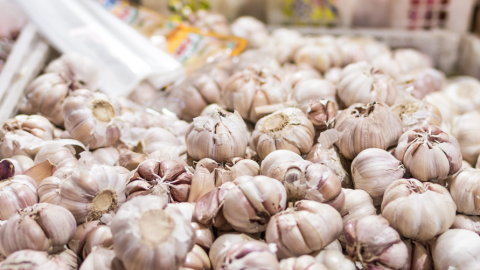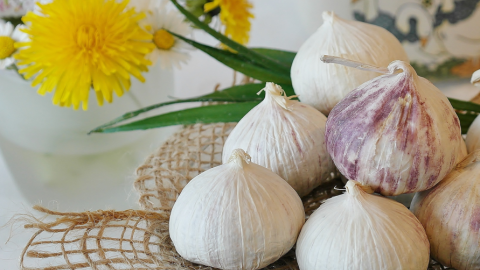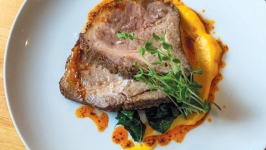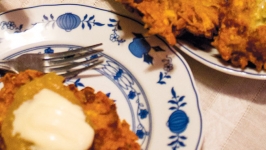Garlic: A Love Story
I am a 19-year-old college student, working afternoons as an intern on a small organic farm in southern Illinois. Half-bushel baskets of dirt-encrusted bulbs line the barn walls near the open doors. Farmer Walt pulls a stool out of a corner into the light and drags over a basket of garlic. I follow suit, and we sit together—me asking dozens of questions, him patiently answering as he demonstrates how to “crack” the garlic: splitting open papery heads with his weathered hands, gently separating the cloves. This is hardneck garlic, with four to six cloves in each bulb, consistently sized except for the occasional shriveled bit, which we will feed to the pigs.
It was just the first day of many spent with garlic on “R” Farm; we worked on and off, between other chores, until we had 10,000 cloves ready for October planting. Cracking the garlic could have been monotonous, but it wasn’t. It was deeply grounding to sit in the shelter of the barn, massaging smooth bulbs in my fingers, surrounded by the pungent aroma—like pesto, like my mother’s kitchen before dinner.
Sometimes I worked with Walt, but often I worked alone. I fell into a rhythm with garlic and found a peace I didn’t know I was missing.
I loved my academic classes: French, philosophy, natural history. Studying at a liberal arts college on the bluffs overlooking the Mississippi River was a dream come true; my full-time job was to spend hours deeply engaged in books. But cracking garlic was unexpectedly satisfying. Why did I feel so at home here in the barn, miles away from my beloved library study carrel and hundreds of miles from my family and the woods in Michigan?
Cracking the garlic was necessary in an immediate way so different from my studies. And, in fact, everything I did in college took on new meaning that fall as I participated in the growing of food, in the essential act of feeding people. Sitting alone in a pair of old jeans, far from everything familiar to me, covered in dirt and bits of garlic skins, I began to discover a great affection for farming.
I worked on Walt’s farm for only one college quarter. Before I finished my internship, we put all the garlic in the ground as Walt told me stories of what was to come: the nine months needed for garlic to grow; the sweaty July harvest when all the bulbs must come out of the ground in a single day; the way the barn would reek while heads cured during the heat of summer; the money he hoped people would pay in upscale St. Louis markets for this stinking rose; the balance between selling and saving enough to plant again in the fall.
I left the farm just before Thanksgiving, knowing intimately only one season of the garlic life cycle. And yet, it was enough. Enough for garlic to lay a claim to me.
Years later my husband and I received garlic as a wedding gift. Two days after our wedding, we said goodbye to Northern Michigan and drove to an apartment in Pittsburgh with a brown paper bag full of “Meadowlark Red” grown in Leelanau County and given to us by dear farmer friends. That fall we cracked open the bulbs and planted two dozen cloves in our community garden, a 20- by 20- foot section on the edge of a city park. The garlic came up in the spring and nourished us and our new friends all summer. We served garlic in our salad dressings, garlic on our pizzas, garlic in pesto sauce. Garlic fed us and our growing baby. In eating Leelanau-born garlic, we were never far from home. A few weeks after our first little girl was born that fall, we planted cloves again.
When Northern Michigan called us home, we carried a bag of our garlic to Traverse City. There in a little downtown garden plot, we put down roots. In that city yard, our two daughters learned to love garlic scapes, the curly tips that emerge in June and need to be snapped off so the plants will send all their energy down into the bulbs. Our girls ran around the garden, pretending the scapes were snakes and wearing them as bracelets while I cooked them into stirfry and added them to sushi rolls.
Up until this point, we’d only grown a couple dozen heads a year. There wasn’t enough room in our Pittsburgh community garden or enough sun in our Traverse City lot to grow more. So we savored our garlic, disciplining ourselves not to eat it all but to save enough for replanting. After a long search, we found land in Leelanau County with space to grow a bigger garden, raise chickens and plant more garlic. We must have asked our Meadowlark farmers for extra bulbs that fall, because according to my garden notebook, we planted 76 cloves the first October at our new home. It felt like we were almost a farm. Walt would have been proud.
Every year since, we’ve planted more garlic. And the more garlic we grow, the more we use and share, and the more creative we have become with this culinary delight. We put whole cloves into our fermented pickle jars. We make massive quantities of pesto to eat fresh and to freeze for the winter. We mix up a fermented garlic paste that tastes delicious with almost every meal. We put garlic in bone broth and in fresh salsa.
Perhaps the most satisfying of all is simply going down into our basement in the middle of January and choosing a head of garlic to bring upstairs to the kitchen. To unwrap the gift of summer growth, ripe and rich when the snow flies, is to suddenly come under the spell of garlic. To cook dinner for family and friends with our own garlic during the darkest season of the year: This brings us unmistakable light.
Garlic harvest at our house has become one of the most anticipated days of summer. Our three children love to pull up the mysterious bulbs that have been swelling under the earth for nine months almost as much as I do. As we pull out the garlic, always, there are questions. Why do we have to plant garlic in the fall? How does each clove turn into an entire head? And those snake-like garlic scape bracelets: What would happen if we let them uncurl, flower and make seeds?
Even though there is familiarity in the rhythm of garlic, the miracle of growing has only deepened year after year, especially at planting time. When I sit on the warm autumn ground with a basket of bulbs ready to be cracked, my children shouting and playing (and sometimes helping) nearby, I am held by the incredibly grounding force of garlic and the affection I first tasted those years ago in the barn.
Planting garlic in October is like a promise: Our long northern winter will pass, spring will arrive and garlic will emerge from the earth. Storms come and go. Garlic is there. Other garden plants are damaged by pests or drought and garlic grows on, undisturbed. Relationships become strained, loved ones get ill, politics are unpredictable. Garlic is there. And we will save the bulbs, and we will plant the cloves, and garlic will come up and garlic will nourish our family again and again.








